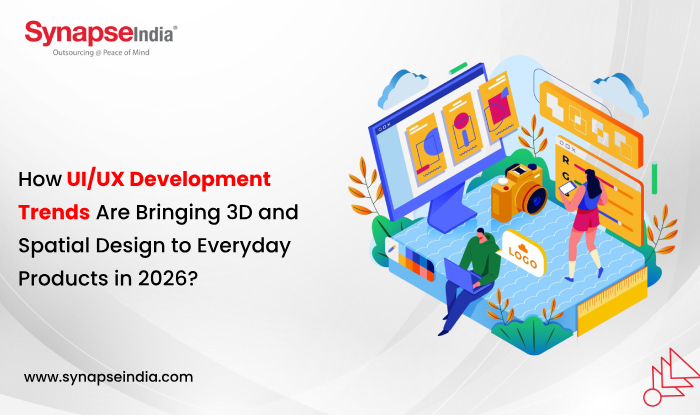 17 Nov 2025
17 Nov 2025“Discover how modern UI/UX development blends 3D visuals, motion, & spatial interactions to create more immersive experiences across apps & digital products.”

The way people interact with digital products is changing fast. In 2025, augmented reality (AR) tools in mobile apps improved user engagement by 45% (Hyqoo).
As a leading UI UX development company in the USA, we see a strong shift where 3D and spatial design are making digital experiences feel more natural. This shift makes products more intuitive, interactive, and closer to how people perceive things in the real world.

AR market value reached $46.6 billion in 2025 (Statista). Designers are moving away from flat layouts and bringing in 3D visuals that add depth and interaction. People now look for experiences that feel more real and engaging on screens.
The shift is supported by better devices, faster rendering tools, and wider browser compatibility. These make it easier to include motion, layers, and subtle spatial effects in everyday designs.
In our UI UX Development Services, we blend simple 3D elements with clean layouts. This balance keeps apps user-friendly while adding a sense of depth and visual appeal that draws attention naturally.
Spatial design treats the screen as a space where objects can move and react naturally. It helps users interact with apps more intuitively. Key changes in app interaction include:
Headset shipments for spatial computing have increased, showing that adoption is growing quickly. Most users preferred apps with spatial navigation. These designs make interactions smoother, reducing confusion and keeping users engaged for longer.
Everyday applications now need more immersive and responsive interfaces. With people expecting faster and more engaging interactions, 3D elements create a more memorable experience. Current data trends show:
We focus on optimizing UI UX design for performance, even on older devices. By maintaining lightweight 3D assets and testing across environments, we help brands deliver fluid and interactive experiences without technical friction.
3D and spatial trends are shaping how users experience digital content. From remote work to entertainment, the move toward spatial interfaces is clear. As experts in UI UX development, we combine familiar layouts with spatial depth to make digital experiences smarter and easier to use.
Data from Google Design shows that apps with spatial features retain users 35% longer. The key is balance, keeping interactions simple while adding depth that feels meaningful and functional.
At SynapseIndia, we understand that each product needs thoughtful design built on user behavior. Our team has created 3D interfaces for over 200 clients across industries. We focus on clarity, usability, and speed while adapting designs to different user needs.
With our USA-based operations, we provide timely collaboration and support. Through our UI UX Development Services, we help businesses make digital experiences more human, interactive, and future-ready.

3D and spatial design are becoming a regular part of how users engage with technology. These trends make interactions more natural and visually engaging. We help businesses adopt these advancements without complexity, blending functionality with simplicity.
As 2026 approaches, adapting to spatial UI UX development will help brands stay relevant and user-focused.
Projects start around $10,000–$20,000 and can go higher for complex 3D integrations depending on scope and duration.
It usually takes 3–6 months based on project goals. Smaller improvements may be completed within a few weeks.
Yes. Entry-level integrations start under $5,000, while customized designs can be scaled as needed.
UI is about how a product looks and feels, while UX is about how easily users can interact with it.
No. Most testing works on standard systems, but real-device testing offers more accurate results.

 21 Oct 2021
21 Oct 2021
